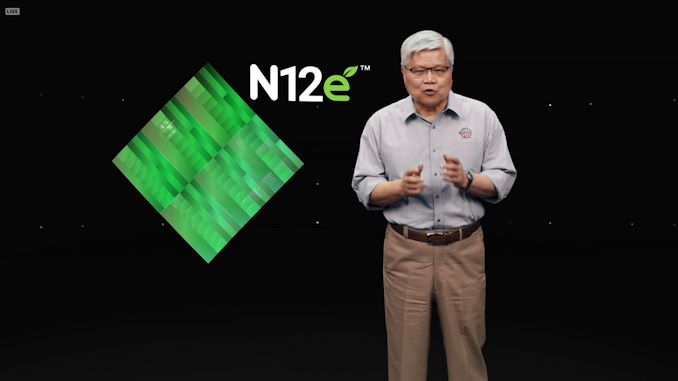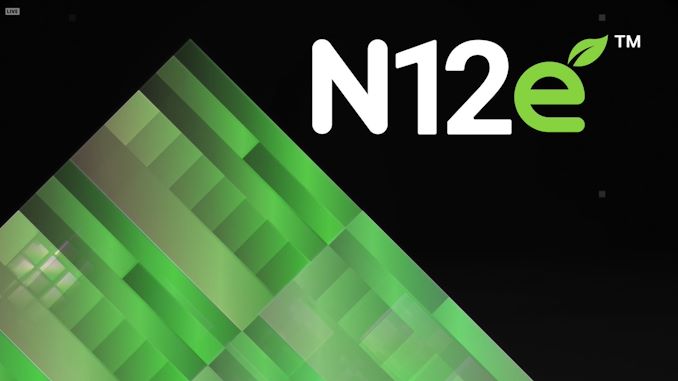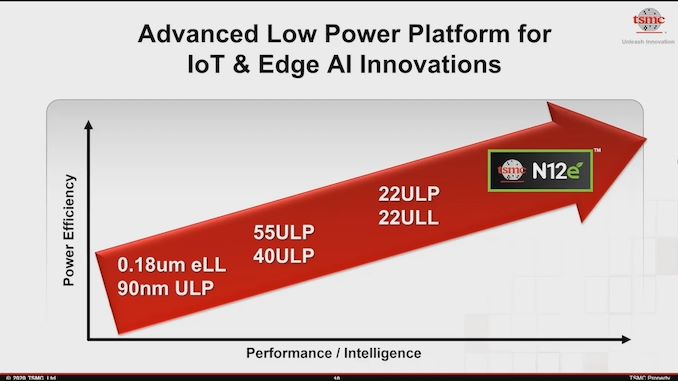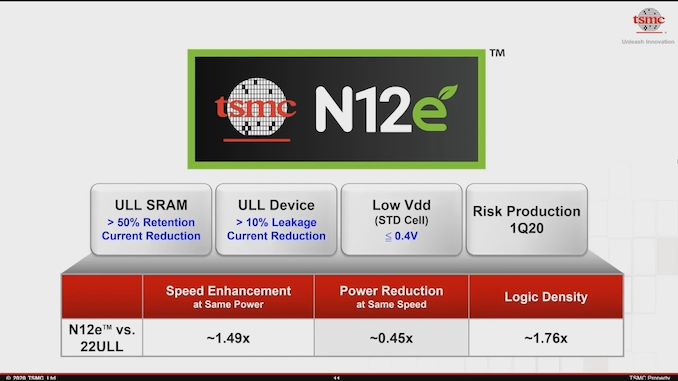TSMC Launches New N12e Process: FinFET at 0.4V for IoT
by Dr. Ian Cutress on August 27, 2020 3:00 PM EST
One of the main drivers for the semiconductor industry is the growth in always-connected devices that require silicon inside, either for compute, communication, or control. The ‘Internet of Things’ era, depending on who you speak to, is set to scale to many billions of devices and subsequently many billions of dollars in opportunities. In order to drive this segment, semiconductor foundries have been developing cost-effective low power process node technologies for its customers to help drive a new level of power efficiency and low cost implementations. TSMC’s newest process targeting this market was announced at its 2020 Technology Symposium, and is to be called N12e.
TSMC’s roadmap for its low powered platforms has centered around popular process node technologies optimized for low power and low leakage. Over the past decade TSMC has offered low power versions of 90nm, 55nm, 40nm and 22nm, with each generation giving smaller die areas and lower power, as well as other design optimizations specific to each need. These have all been planar technologies, however the new N12e process node is the next generation, and based on FinFETs.
FinFETs are, in a like-for-like scenario, more complex to build than planar transistors, and therefore should naturally cost more to produce. However, FinFET technologies also provide benefits in scaling and power, something this market is interested in. Rather than introduce FinFETs earlier in the cycle, TSMC has waited a few generations until it can deploy its most advanced FinFET designs to this market, to help ease the transition with the benefits that a most optimized design could bring.
Within N12e compared to 22ULL, TSMC is promising a 1.49x increase in frequency at iso-power, or a 55% reduction in power at iso-speed. This also comes with a 1.76x increase in logic density, and a specialist low-voltage cell library capable of 0.4 volts. This extends the range of TSMC’s IoT process node offerings to a lower power bracket, as well as giving a better performance profile at all other powers as well.
N12e brings together technology from TSMC’s 16nm process and couples it with improvements and experience from 12FFC+, both of which have been used extensively in high performance computing. TSMC believes that integrating this with its ultra-low-leakage knowledge will help enable the next generation of 5G-enabled IoT Edge devices, by providing low power routes to AI accelerators for speech recognition, health monitoring and machine vision.
The main competitor to N12e would be GlobalFoundries 12FDX platform, which is built on GF’s 12nm FD-SOI technology, with claims of better power consumption and lower cost than equivalent FinFET designs. However despite talk of 12 FDX for several years (and news of new MRAM support and such), there have been no public design wins for the process.
It is unclear when TSMC will start taking orders for its N12e platform, however the company has said it is ‘excited’ for the next generation of products built on it.
Source: TSMC N12e
Related Reading
- TSMC Details 3nm Process Technology: Full Node Scaling for 2H22 Volume Production
- TSMC To Build 5nm Fab In Arizona, Set To Come Online In 2024
- TSMC & Broadcom Develop 1,700 mm2 CoWoS Interposer: 2X Larger Than Reticles
- TSMC Boosts CapEx by $1 Billion, Expects N5 Node to Be Major Success
- Early TSMC 5nm Test Chip Yields 80%, HVM Coming in H1 2020
- TSMC: 5nm on Track for Q2 2020 HVM, Will Ramp Faster Than 7nm
- TSMC: N7+ EUV Process Technology in High Volume, 6nm (N6) Coming Soon
- GlobalFoundries' 22FDX with MRAM is Ready
- GlobalFoundries Announces 22FDX Milestone: $2 Billion in Design Wins



















26 Comments
View All Comments
abufrejoval - Thursday, August 27, 2020 - link
Well there are far too many value issues and operational challenges to IoT, that somehow got ignored in all the hype: Just having the equivalent of a mainframe costing millions and munching megawatts on a chip costing pennies and munching milliwatts isn't enough.But I'm sure there will be plenty of stuff to profit from these low-power processes, especially since you don't need to produce your entire SoC 'aggregate' with a single process technology any more.
If some company finds ways of producing 'chunky chocolate chips' at massive scale and low cost via robotics or something better, things are bound to happen.
And where there is an actual demand, some engineers will find a solution.
FunBunny2 - Friday, August 28, 2020 - link
"If some company finds ways of producing 'chunky chocolate chips' at massive scale and low cost via robotics or something better, things are bound to happen."yeah if that becomes the widespread paradigm, such a production mode is doomed. no people, no income, no demand, no sales. too many folks compare today's sloughing off of employment to the 'great migration' from farm to city in the early part of the 20th century. but that movement was possible because the skills needed to work in a structured manufacturing operation were even less than what was needed to farm successfully. today, those being made redundant have neither the basic education and skills to transition to the 'new information economy'. in the 60s, for those who weren't there, the computer revolution was manned (almost all men) by COBOL programmers with, at most, high school education trained by the US military, for free (well, not counting time in service).
MrCommunistGen - Thursday, August 27, 2020 - link
Does anyone know what (if any) design wins the previous 22ULL had? Mostly just trying to see what future products we might see N12e in. Yeah, IoT, but what?A lot of low cost devices just use off the shelf SoCs from yesteryear made on old, cheap processes because lowest possible BOM hugely outweighs performance or power efficiency in those designs.
brucethemoose - Thursday, August 27, 2020 - link
Yeah, I can see new nodes being an increasingly tough sell for IOT.FunBunny2 - Friday, August 28, 2020 - link
"off the shelf SoCs from yesteryear made on old, cheap processes because lowest possible BOM "depends. if the product does distributed database functions in order to facial recognition find progressive anarchists in real time, yeah, then you need more compute than a 4-function calculator. in any case IoT will, in the end, depend more on internet speed than compute on the devices. and mmWave 5G, the only kind that provides real bandwidth increase, is mostly going to be in cities (Blue havens of progressive anarchists), so the Stasi will need a lot of compute on their Dick Tracy Wrist TV.
Hardware Geek - Saturday, August 29, 2020 - link
Even on Anandtech one can't escape the constant barrage of politics. It's pathetic, pointless, and completely irrelevant to the discussion.Spunjji - Tuesday, September 1, 2020 - link
Politics is everywhere whether you like it or not. Normally I'd agree about irrelevant applications of it, but FunBunny2's point was pretty relevant because as MrCommunistGen noted, there aren't many consumer use-cases for this process tech because they're primarily cost-focused, while there are plenty of potential state/police/military applications.I say this without really knowing whether or not I agree with FunBunny2's perspective, because it's extremely difficult to tell the intended context of the terms they're using.
Smell This - Sunday, August 30, 2020 - link
**Does anyone know what (if any) design wins the previous 22ULL had?**___________________________________________________________
Maybe a comparison with 22FDX GlobalFoundries "best in class performance, power consumption, integration capability ..."
and GlobalFoundries 12FDX platform versus with TSMC N12e ??
name99 - Thursday, August 27, 2020 - link
"help enable the next generation of 5G-enabled IoT Edge devices"Just because Qualcomm spouts this BS about how IoT devices are automatically 5G-enabled devices doesn't mean Ars has to play along with their lies.
How many IoT devices do you have in your house? I have maybe 50 by the time you include all the lights, plugs, sensors, cameras, ...
And how many of them are even cell-enabled, let alone 5G enabled? I thought so...
It makes sense for alarm/security controllers to be cellular enabled. Everything else, WHY? Costs more, uses more power; provides exactly what benefit over zigbee/bluetooth/wifi?
brucethemoose - Thursday, August 27, 2020 - link
It patronizes the poor, poor cell companies?Also, more data mining when wifi is unavailible?